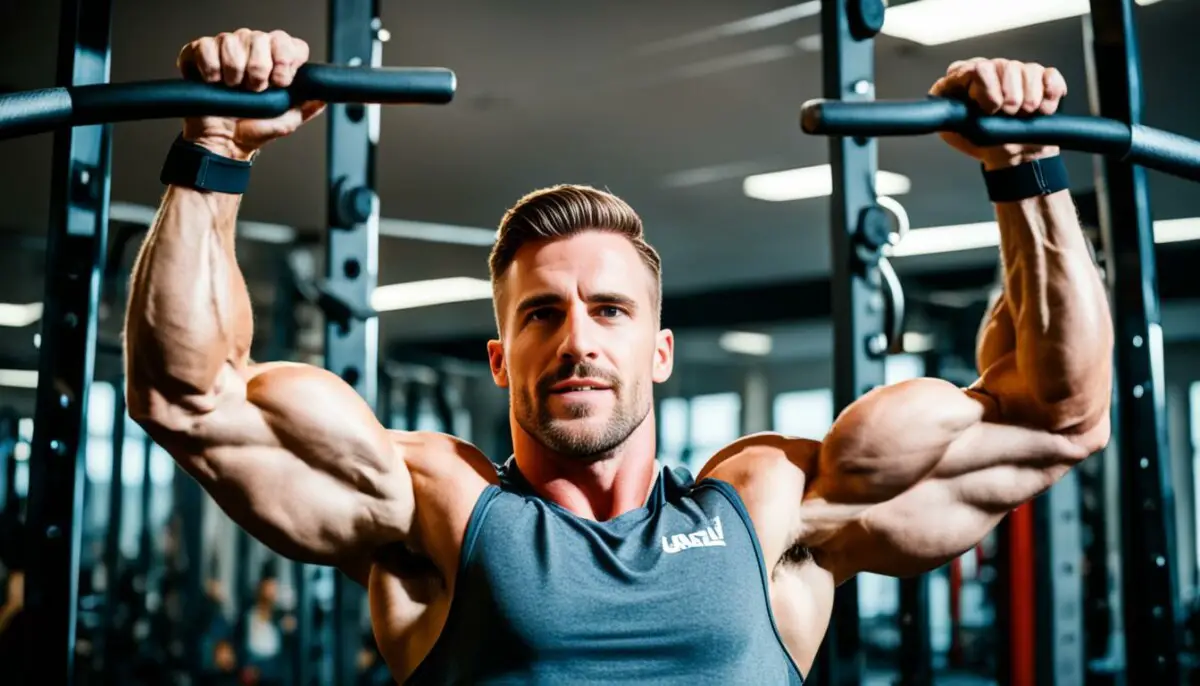Last Updated on 3 months by Francis
In order to achieve a wide back and create a V-taper physique, it is important to focus on specific exercises and training techniques. By targeting the latissimus dorsi, the broadest muscle group of the back, you can develop width and create a more symmetrical appearance. This article will provide you with proven strategies and exercises to help you get a wide back.
When it comes to developing a wider back, a wide-grip approach is key. Wide-grip exercises, where your forearm and upper arm create a right angle, are most effective for targeting the width of the back. These exercises primarily engage the latissimus dorsi, a large, flat muscle that stretches to the sides and behind the arms. Incorporating wide-grip exercises into your back training routine can specifically target and develop a wider back.
To effectively stimulate muscle growth in the back, it is important to work the muscles through their full range of motion. By emphasizing the lengthening of the arms and stretching the back muscles during exercises like lat pulldowns and cable rows, you can maximize the stretch and activation of the back muscles, leading to greater development and width.
The back is a fundamental part of overall physique development, particularly in achieving a V-taper physique. Neglecting back training can result in an imbalanced physique and prevent you from reaching your full potential. Both men and women can benefit from back training, as it helps to create symmetry, improve posture, and enhance overall aesthetics. Incorporating back exercises into your training routine is essential for a well-rounded and proportionate physique.
Contents
Key Takeaways:
- Target the latissimus dorsi to develop a wider back.
- Incorporate wide-grip exercises into your back training routine.
- Emphasize full range of motion to stimulate back muscle growth.
- Don’t neglect back training for overall physique balance.
- Benefits of back training include improved posture and aesthetics.
The Wide-Grip Approach

When it comes to targeting the width of your back, wide-grip exercises are your key to success. By adjusting your grip so that your forearm and upper arm form a right angle, you engage the latissimus dorsi, the broadest muscle group in your back. This muscle stretches to the sides and behind the arms, making it the primary focus for developing back width.
By incorporating wide-grip exercises into your back training routine, you can specifically target and develop a wider back. These exercises put more emphasis on the width of your back muscles, helping you achieve the V-taper physique you desire.
Why Wide-Grip Exercises?
Wide-grip exercises primarily engage the latissimus dorsi, which is a large, flat muscle that contributes to the width of your back. By widening your grip, you maximize the activation of this muscle group and stimulate its growth.
Not only do wide-grip exercises focus on width, but they also provide an effective way to develop overall back strength and stability. By challenging your muscles with a wider grip, you improve their functionality and enhance your performance in other exercises and activities.
Here are some popular wide-grip exercises that you can incorporate into your back workout routine:
| Exercise | Description |
|---|---|
| Pull-ups | Hang from a bar with an overhand grip, wider than shoulder-width apart. Pull your body upward until your chin is above the bar, then lower yourself back down. |
| Wide-Grip Lat Pulldowns | Using a cable machine, attach a wide-bar handle and sit facing the machine. Grasp the handle with a wide overhand grip and pull it down to your upper chest, then slowly release it back up. |
| T-Bar Rows | Stand with your feet shoulder-width apart, straddling a T-bar handle. Grip the handle with both hands, keeping your palms facing each other. Pull the handle toward your abdomen, then slowly lower it back down. |
Remember to maintain proper form and technique while performing these exercises to maximize their effectiveness and minimize the risk of injury.
By incorporating these wide-grip exercises into your back training routine, you can focus on developing a wider back and achieving the V-taper physique you desire.
Achieving a Full Range of Motion
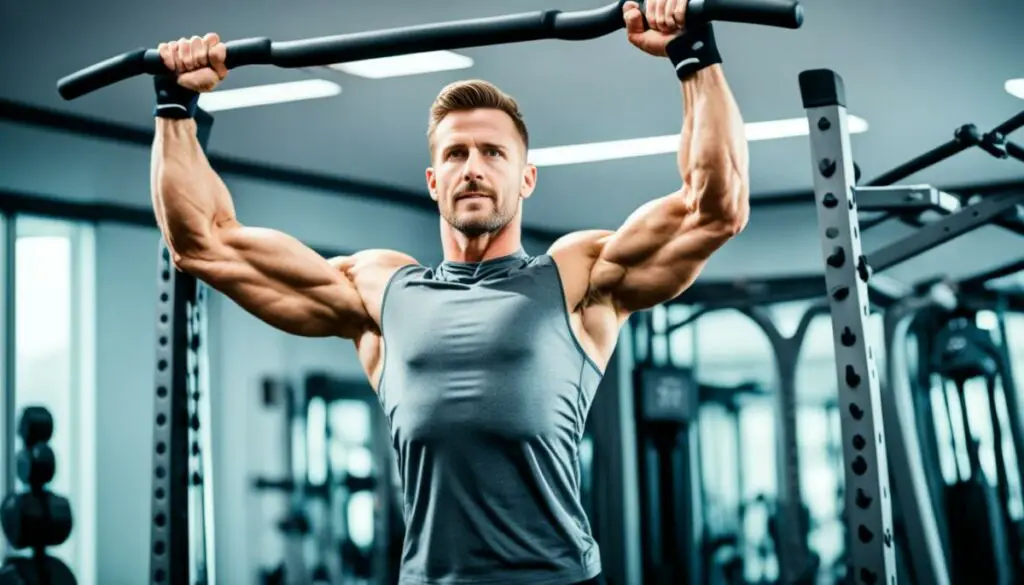
To effectively stimulate muscle growth in the back, it is important to work the muscles through their full range of motion. This means allowing the back muscles, especially the latissimus dorsi, to be fully stretched during the eccentric phase of the exercise. By emphasizing the lengthening of the arms and stretching the back muscles during exercises like lat pulldowns and cable rows, you can maximize the stretch and activation of the back muscles, leading to greater development and width.
To optimize muscle stimulation and enhance back development, focus on the following:
1. Full Range of Motion
Perform exercises with a full range of motion, ensuring that you fully extend and contract the back muscles. Emphasize the stretch during the eccentric phase of each exercise, allowing the muscles to lengthen and elongate.
2. Lat Pulldowns
Lat pulldowns are an excellent exercise for targeting the back muscles, including the latissimus dorsi. Use a wide-grip handle and pull the bar down towards your chest, fully stretching the back muscles before returning to the starting position.
3. Cable Rows
Cable rows are another effective exercise for working the back muscles and achieving a full range of motion. Sit upright on a cable row machine, grasp the handles with an overhand grip, and pull the handles towards your body, focusing on contracting the back muscles at the peak of the movement.
4. Stretching
Incorporate stretching exercises specifically targeting the back muscles into your routine. Stretching after your workout can help increase flexibility, improve posture, and prevent muscle imbalances.
By following these techniques and incorporating exercises that promote a full range of motion, you can optimize muscle stimulation and enhance the development of your back muscles. Remember to always perform exercises with proper form and consult with a fitness professional or trainer if you have any concerns or questions.
| Benefits of Full Range of Motion | Tips for Stretching the Back Muscles |
|---|---|
|
|
The Importance of Back Training
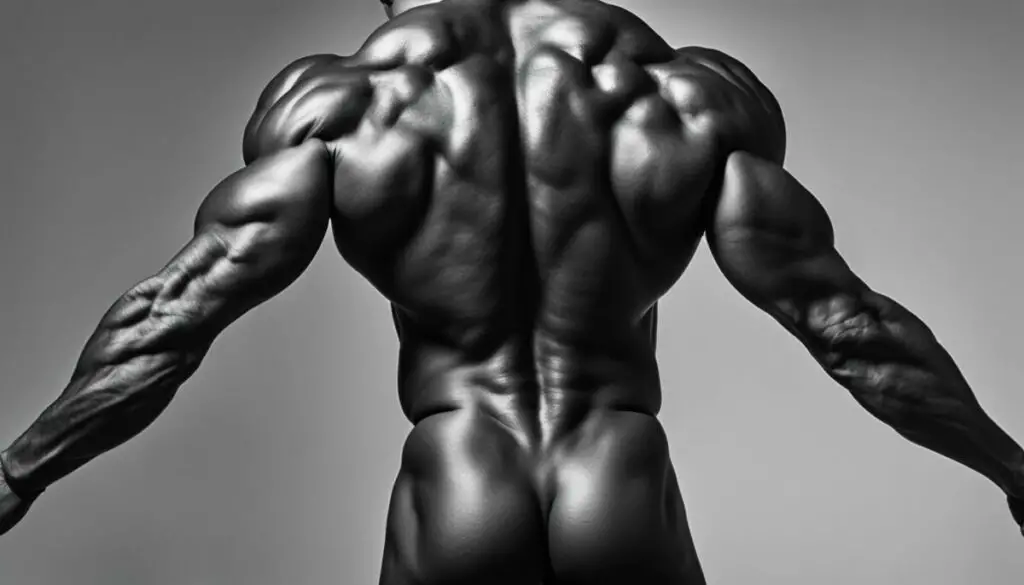
The back is a fundamental part of overall physique development, particularly in achieving a V-taper physique. Neglecting back training can result in an imbalanced physique and prevent you from reaching your full potential. Both men and women can benefit from back training, as it helps to create symmetry, improve posture, and enhance overall aesthetics. Incorporating back exercises into your training routine is essential for a well-rounded and proportionate physique.
When it comes to developing a V-taper physique, a well-developed back plays a crucial role. A V-taper refers to the desirable shape of the human body: a narrow waist accompanied by broad and muscular shoulders. The back muscles, especially the latissimus dorsi or “lats,” contribute significantly to this aesthetic. By engaging in targeted back training exercises, you can sculpt a wider back, enhance your overall physique balance, and achieve that coveted V-taper look.
Back training is not limited to appearance benefits alone. It also has functional advantages, such as improved posture and increased strength for daily activities. Additionally, a well-developed back provides stability and support for other major muscle groups during compound movements like squats and deadlifts. Therefore, incorporating back exercises into your training routine ensures a well-rounded and balanced physique.
Both men and women can benefit from back training. While men often desire a wider back to accentuate their masculine physique, women can achieve a more balanced appearance by developing their back muscles. Building a strong back can also help improve overall posture, reducing the risk of back pain and injuries.
When designing your back training program, it’s important to focus on exercises that target all areas of the back, including the upper, middle, and lower regions. Incorporating compound movements like rows, pull-ups, and deadlifts, along with isolation exercises such as lat pulldowns and reverse flyes, allows for comprehensive muscle development and ensures overall balance in your physique.
“A well-developed back not only enhances your aesthetics but also provides significant functional benefits. It improves posture, increases strength, and reduces the risk of injuries. Don’t neglect this essential part of your training routine!”
The Top Exercises for a Wide Back
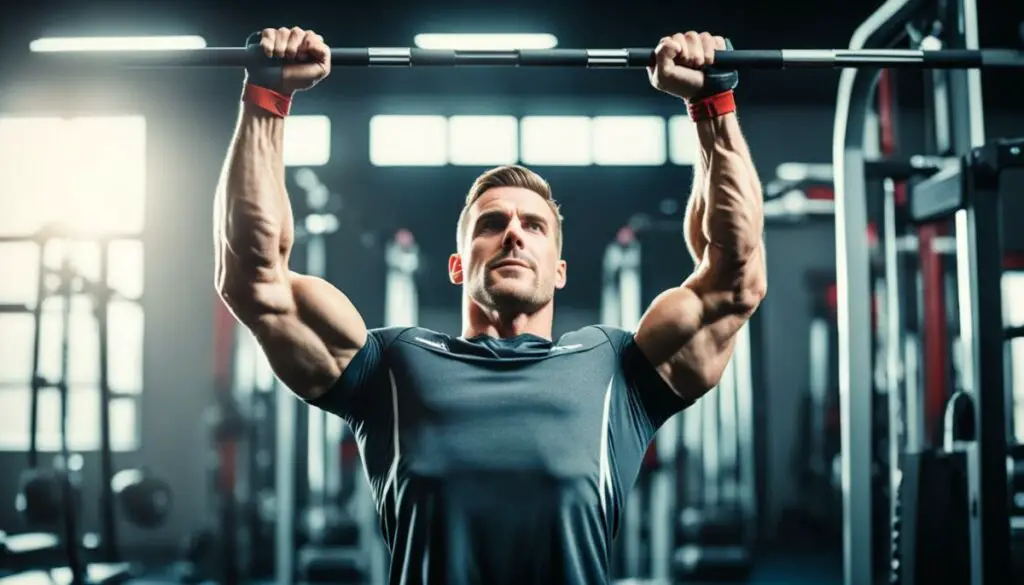
To build a wide back, it’s essential to include specific exercises in your training routine that target the muscles responsible for creating width. Incorporating these exercises will help you develop a broader and more impressive back.
Pull-ups or Chin-ups
Pull-ups and chin-ups are unparalleled in their ability to target the back muscles and are highly effective for building width. These compound exercises engage the latissimus dorsi, rhomboids, and other muscles in the upper back, promoting overall back development. Performing variations of pull-ups and chin-ups, such as wide-grip or neutral-grip, can further emphasize the width-building aspect, ensuring optimal results.
Rows (Barbell or Dumbbell)
Rows, including barbell rows and dumbbell rows, play a crucial role in building thickness and width in the back. These exercises primarily target the muscles in the mid-back, such as the rhomboids, trapezius, and rear deltoids. By including different rowing variations, you can effectively stimulate muscle growth and achieve a well-rounded back.
Deadlifts
Deadlifts are a compound movement that engages multiple muscle groups, including the back. By performing deadlifts, both conventional and Romanian, you not only build overall back strength but also contribute to back width development. Deadlifts target the erector spinae and the muscles in the lower and middle back. These lifts also promote core stability and strengthen the posterior chain, making them a valuable addition to any back-focused training program.
Sample Workouts for a Wide Back
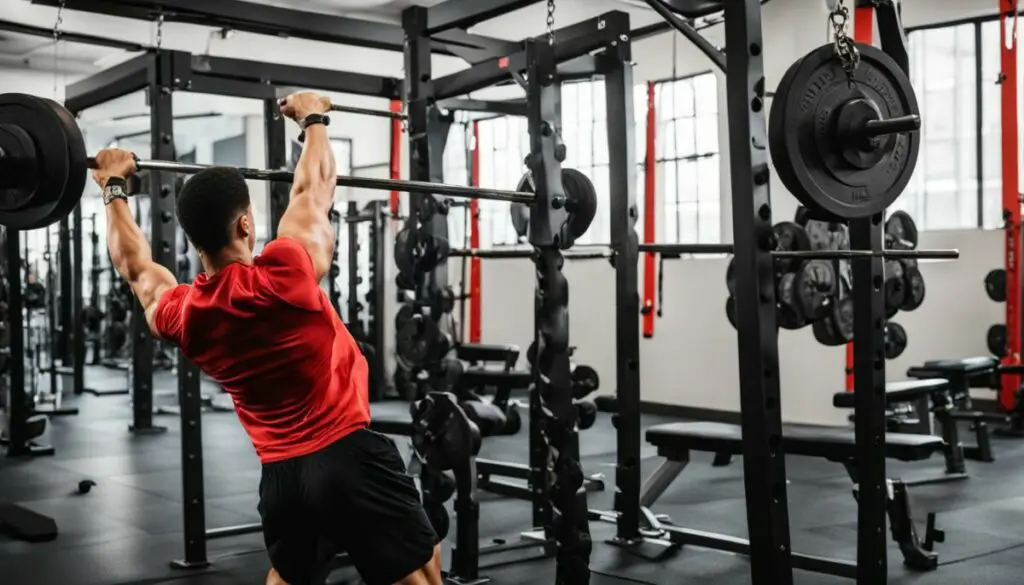
Building a wide and well-developed back requires a strategic and effective workout routine. Incorporating exercises that target the width of the back is essential for achieving the desired V-taper physique. Here are two sample workouts to help you develop a wide and impressive back:
Upper Body Workout A
- Chin-ups: 7 sets of 3 reps
- Dips: 6 sets of 5 reps
- Chin-ups: 6 sets of 5 reps
- Dips: 6 sets of 5 reps
- Chin-ups: 1 set to failure
- Dips: 1 set to failure
This workout focuses on exercises that engage the back muscles, specifically targeting width. Chin-ups are a challenging and effective exercise for developing a wide back, while dips help to strengthen and define the muscles in the upper body. The workout consists of multiple sets and varying rep ranges to stimulate muscle growth and promote strength development.
Image of Wide Back Workout
Remember to maintain proper form and technique throughout each exercise to maximize the benefits and minimize the risk of injury. It is also important to gradually increase the intensity of your workouts over time to keep challenging your muscles and promoting progress.
By incorporating these sample workouts into your training routine and tailoring them to your fitness level, you can effectively target the width of your back and achieve the desired V-taper physique. Consistency and dedication are key to achieving your fitness goals, so make sure to stay motivated and keep pushing yourself in each workout.
Importance of Balance in Training
Achieving a wide back is just one aspect of overall muscle development and physique enhancement. While building a wide back is crucial for a well-rounded physique, it is equally important to maintain balance in your training program. By incorporating exercises that target all muscle groups, you can achieve a well-rounded physique that not only looks great but also functions properly.
Why is balanced training important?
When it comes to fitness, balance is key. Focusing on overall muscle development ensures that your body remains functionally strong and capable of performing day-to-day activities with ease. By giving equal attention to different muscle groups, you can prevent muscle imbalances, which can lead to poor posture, increased risk of injuries, and hindered performance.
Having a well-rounded physique not only means having a wide back but also having developed muscles in other areas such as the chest, shoulders, arms, and legs. This balanced development creates symmetry and proportion throughout the body, enhancing overall aesthetics and improving overall body mechanics.
How to achieve a well-rounded physique?
To achieve a well-rounded physique, incorporate exercises that target all major muscle groups into your training program. This includes exercises for the chest, shoulders, back, arms, and legs. Here are some examples:
- Chest: Bench press, push-ups, dumbbell flies
- Shoulders: Overhead press, lateral raises, upright rows
- Arms: Bicep curls, tricep dips, skull crushers
- Legs: Squats, lunges, deadlifts
Remember, a well-rounded physique is not only visually appealing but also functional and healthy. By incorporating exercises for all muscle groups, you can achieve overall muscle development and balance in your physique.
Incorporating balanced training into your fitness regimen not only enhances your aesthetic appearance but also improves your overall health and well-being. By focusing on overall muscle development and symmetry, you can create a physique that is not only visually pleasing but also functional and strong.
The Role of Genetics in Back Development
When it comes to back development and muscle shape, genetics can play a significant role. Each individual has their own genetic potential, which influences factors such as the width of the back and the overall shape of the back muscles. While some individuals may naturally have a wider back due to genetic factors, others may have to put in more effort to achieve similar results.
It’s important to understand that genetics provide a baseline for what is possible, but they do not limit your ability to make progress. Even if you do not have the genetic advantage of a naturally wide back, you can still work towards developing a wider back through targeted training and proper techniques.
By focusing on exercises that specifically target back width and incorporating them into your training routine, you can maximize your genetic potential and make significant improvements. While individual variations exist, everyone has the ability to shape and strengthen their back muscles to achieve a more aesthetically pleasing physique.
“Genetics loads the gun, but lifestyle pulls the trigger.” – Dr. Mehmet Oz
It’s important to remember that while genetics may provide a starting point, your dedication and consistent effort are what will ultimately determine your back development. By working within your genetic potential and staying committed to your training routine, you can achieve the best possible results and unlock your full genetic potential.
So, don’t let genetics discourage you. Embrace your individuality and focus on your own progress, knowing that with the right training and a dedicated mindset, you have the power to transform your back and achieve the wide, strong physique you desire.
Tips for Back Training
When training your back, it’s crucial to keep a few key tips in mind to maximize your results and reduce the risk of injury. Here are some essential pointers:
- Maintain Proper Form: Maintaining proper form is paramount when targeting your back muscles. By using correct technique, you can effectively engage the targeted muscles and minimize the risk of strain or injury.
- Focus on Progressive Overload: Progressive overload is the key to continued muscle growth and development. Gradually increase the weight and intensity of your back training exercises over time to challenge your muscles and stimulate growth.
- Listen to Your Body: Pay attention to how your body feels during and after your back workouts. If you experience pain or discomfort, adjust your technique or reduce the intensity to avoid overtraining and potential injury. Rest and recovery are crucial for muscle growth and overall well-being.
By incorporating these tips into your back training routine, you can ensure proper form, promote continuous muscle growth through progressive overload, and prioritize your overall well-being.
| Back Training Tips |
|---|
| Maintain proper form |
| Gradually increase weight and intensity |
| Listen to your body |
Benefits Beyond Aesthetics
Developing a wide back not only enhances your aesthetics but also provides several other benefits:
- Improved posture and spinal alignment: Building a strong back helps improve your posture by supporting the natural curves of your spine. This can prevent slouching and promote a more aligned and confident stance.
- Increased functional strength: A wide back is a reflection of functional strength, which is essential for performing daily activities like lifting and carrying heavy objects. Strengthening your back muscles can enhance your overall physical capabilities and make daily tasks easier.
- Reduced risk of back injuries and pain: Poor back strength and posture can lead to back pain and injuries. By developing a wide back and maintaining proper alignment, you can reduce the risk of chronic back issues and discomfort.
- Improved overall body mechanics and movement patterns: A strong and wide back is crucial for maintaining proper body mechanics and movement patterns. It improves stability and coordination, allowing you to move efficiently and effectively in various activities and sports.
Regular back training can have a significant impact on your overall well-being, beyond just the aesthetics. By focusing on posture improvement, functional strength, and injury prevention, you can achieve not only a wide back but also a healthier and more functional body.
Conclusion
Building a wide back is crucial for achieving a well-rounded and proportionate physique. By incorporating wide-grip exercises into your back training routine, focusing on full range of motion, and maintaining a balanced training program, you can work towards achieving a V-taper physique. It is important to listen to your body, prioritize proper form, and gradually increase the intensity of your workouts for continuous progress. With dedication and consistency, you have the power to transform your back and enhance your overall physique.
Remember, a wide back not only improves your aesthetics but also provides a range of other benefits. It can help improve your posture and spinal alignment, increase your functional strength for everyday activities, reduce the risk of back injuries, and improve your overall body mechanics and movement patterns.
So don’t wait any longer, start your wide back journey today! Embrace the wide-grip exercises, focus on your range of motion, and maintain a balanced training program to achieve the wide back transformation you desire and create that V-taper physique you’ve been working towards. With the right approach and consistent effort, you can reach your goals and unlock your full potential.
FAQ
How can I get a wider back?
To develop a wider back, focus on exercises that target the latissimus dorsi, such as wide-grip exercises. These exercises primarily engage the broadest muscle group of the back and help to create width.
What are the best exercises for a wider back?
Some of the top exercises for a wider back include pull-ups, chin-ups, rows (barbell or dumbbell), and deadlifts. These exercises specifically target the back muscles and promote width.
How important is it to maintain a full range of motion during back exercises?
It is crucial to work the back muscles through their full range of motion. By emphasizing the lengthening and stretching of the arms during exercises like lat pulldowns and cable rows, you can maximize the stretch and activation of the back muscles, leading to greater development and width.
Why is back training important for overall physique development?
Back training is essential for overall physique development because it helps to achieve a V-taper physique and create symmetry. Neglecting the back can result in an imbalanced physique and prevent you from reaching your full potential.
How can I incorporate back exercises into my training routine?
To build a wide back, include exercises such as pull-ups, chin-ups, rows, and deadlifts in your training routine. These exercises should be performed with proper form and gradually increasing weight and intensity for continuous muscle growth.
Are genetics a factor in back development?
Genetics can play a role in back development and muscle shape. Some individuals may naturally have a wider back due to genetic factors, while others may have to work harder to achieve similar results. It is important to focus on your own progress and work within your genetic potential.
What are some tips for back training?
Tips for effective back training include maintaining proper form, gradually increasing weight and intensity, and allowing for proper rest and recovery between workouts. Listening to your body and avoiding overtraining is also important for preventing injuries.
What are the benefits of developing a wide back?
Developing a wide back not only enhances your aesthetics but also improves posture and spinal alignment, increases functional strength, reduces the risk of back injuries and pain, and improves overall body mechanics and movement patterns.
How can I achieve a well-rounded and proportionate physique?
Achieving a well-rounded and proportionate physique involves balancing your training program by incorporating exercises for all muscle groups, including the back. Training for overall strength and functionality is key to developing a balanced physique.

